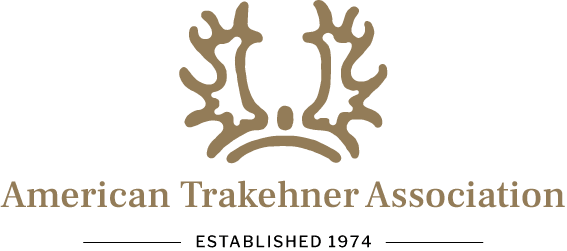The breeding goal is a riding and sport horse of Trakehner type, that is rideable and talented for many uses.
The selection criteria are the following:
The breed is based on the population of warmblood horses of Trakehner origin created in East Prussia, which carry high percentages of Thoroughbred and Arabian as well as Shagya Arabian and Anglo-Arab genes. Trakehners have a closed studbook, with only Trakehners, Thoroughbreds, Arabians, Shagya Arabians, and combinations thereof being permitted. The current Trakehner population derives principally from the hardy survivors of World War II, when the Trakehner herds were significantly depleted by the ravages of that war.
Colors: All colors
Size: The objective is a height between 160 centimeters to 170 centimeters, measured at the withers (15.3 hands to 16.3 hands).
Type: Trakehner type, based upon the historical appearance of the Trakehner horse, is highly desired. Breeding goals include a highly elegant appearance, a noble expression, harmony of body and movement, a well-defined, expressive head, a large and intelligent eye, a well-shaped neck, sculpted muscles, and correct, clearly defined limbs and joints. Breeding stallions and broodmares should also display the typical expression of their gender.
Undesirable traits include a coarse appearance, lack of harmonious lines, a big head, indistinct outlines, undefined joints, and in breeding stock, lack of gender expression.
Conformation: Desirable is a large and harmonious body that enables the horse to perform in equestrian sport. This includes a medium-long neck that tapers towards the head; good freedom in the throatlatch; a large, sloping shoulder; well-defined withers that extend far into a back that is able to perform its function; a long, slightly sloping, powerfully muscled croup; and a harmonious division of the body into forehand, mid-section, and hindquarters. Conformation should be optimal for an athletic sporthorse and permit movement that combines swing, thrust, and balance.
Also desirable is a well-defined foundation matching the body with correct, large joints, medium-long pasterns, and well-shaped hooves that promise soundness and long years of use. In addition, the foundation should include correctly positioned legs – straight when seen from behind, forelegs that are straight when seen from the side, hind legs that have well-coupled hocks set at an angle of approximately 150 degrees, with each leg having a straight toe axis that forms a 45-50 degree angle with the ground.
Desirable are diligent, cadenced and ground-covering basic paces (walk – four-beat; trot – two-beat; canter – three-beat). The movement should be elastic and energetic, developed from the hindquarters, transmitted over a supple, swinging back to the forehand, which freely moves forward out of the shoulder. The direction of movement of the legs should be straight and forward.
At the walk, the movement should be supple, energetic and elevated with clearly defined steps. At the trot and canter, there should be a clearly noticeable phase of suspension, with the movement being elastic, full of impulsion and light-footed, carried with balance and natural elevation of the neck. Some knee action is desirable.
Jumping: Desirable is an elastic, scopey and deliberate jumping technique that displays calmness and intelligence. The jumping sequence should clearly show a collecting, a powerful and quick push-off at takeoff; a distinct, quick angling of the limbs (with the forearms being as horizontal as possible over the obstacle), a rounded back with noticeably projecting withers, and a neck that is bent downward while the hind legs open up (bascule). During the entire sequence, the flow of the movement and the rhythm of the canter should be maintained.
Desirable is an uncomplicated, friendly horse that is willing to work, not nervous but reliable, which, in the way it appears and behaves, gives a wide-awake, intelligent impression and reveals a good character and a calm, even temperament.
The breed goal is a talented, sound, large-framed and correct sporthorse of Trakehner type, with harmonious lines. Trakehners should be intelligent, willing, talented, rideable, and reliable. They should have ground covering, elegant, and elastic movements with plenty of impulsion and the ability to jump. The best Trakehners will demonstrate endurance, resilience, and hardiness during work.








